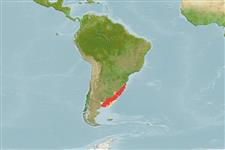Common names from other countries
Environment: milieu / climate zone / depth range / distribution range
Sinh thái học
; Mức độ sâu 0 - 90 m (Ref. 275). Subtropical; 30°S - 44°S, 65°W - 50°W (Ref. 107078)
Southwest Atlantic: from Brazil to Argentina.
Length at first maturity / Bộ gần gũi / Khối lượng (Trọng lượng) / Age
Maturity: Lm ? range ? - ? cm Max length : 30.0 cm TL con đực/không giới tính; (Ref. 105659)
Minimum depth assumed from its ecology. Inhabits intertidal and shallow subtidal zones, on reefs and sandy areas. Found on crevices, boulders and empty gastropod and bivalve shells. Selectively feeds on grapsid crabs and small bivalves. Known to extract living hermit crabs on gastropod shells via drilling. Major source of food for juvenile shark in Argentinean waters (Ref. 96968).
Life cycle and mating behavior
Chín muồi sinh dục | Sự tái sinh sản | Đẻ trứng | Các trứng | Sự sinh sản | Ấu trùng
Members of the class Cephalopoda are gonochoric. Male and female adults usually die shortly after spawning and brooding, respectively. Mating behavior: Males perform various displays to attract potential females for copulation. During copulation, male grasp the female and inserts the hectocotylus into the female's mantle cavity where fertilization usually occurs. Life cycle: Embryos hatch into planktonic stage and live for some time before they grow larger and take up a benthic existence as adults.
Roper, C.F.E., M.J. Sweeney and C.E. Nauen. 1984. (Ref. 275)
IUCN Red List Status (Ref. 130435)
CITES status (Ref. 108899)
Not Evaluated
Not Evaluated
Human uses
Các nghề cá: Tính thương mại
| FishSource |
Các công cụ
Thêm thông tin
Age/SizeSự sinh trưởngLength-weightLength-lengthHình thái họcẤu trùngSự phong phú
Các nguồn internet
Estimates based on models
Preferred temperature
(Ref.
115969): 10.8 - 17.6, mean 14.7 (based on 106 cells).
Vulnerability
Low vulnerability (10 of 100).
